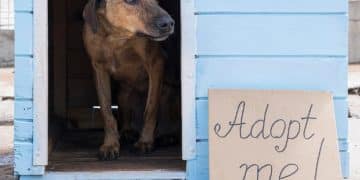Breed-Specific Legislation: Impact on US Animal Shelter Adoptions

Breed-specific legislation (BSL) significantly affects adoption policies at US animal shelters by imposing restrictions or bans on certain dog breeds, leading to increased difficulty in placing these animals and potentially higher euthanasia rates.
The world of animal shelters and dog adoptions can be complex, especially when understanding breed-specific legislation: how it affects adoption policies at US shelters. These laws, often referred to as BSL, can significantly influence which dogs find homes and which ones face a more uncertain future.
What is Breed-Specific Legislation (BSL)?
Breed-specific legislation is a set of laws that target specific breeds of dogs, often those perceived as dangerous or aggressive. These laws can range from outright bans to restrictions on ownership.
BSL can include a variety of measures.
Common Restrictions Under BSL
- Bans: Complete prohibition of owning certain breeds within a jurisdiction.
- Mandatory muzzling: Requiring specific breeds to be muzzled in public.
- Increased insurance: Higher insurance premiums for owners of targeted breeds.
These restrictions can create obstacles for owners and potential adopters, impacting their decisions on which dogs to bring into their families. Often, the breeds targeted are pit bull-type dogs, Rottweilers, and Doberman Pinschers, among others.

Ultimately, BSL aims to reduce dog-related incidents. However, its effectiveness is a subject of ongoing debate, with many arguing that it unfairly punishes responsible owners and does not address the root causes of aggression.
How BSL Affects Animal Shelters
Animal shelters face numerous challenges due to breed-specific legislation, particularly in regions where it is strictly enforced. Shelters must navigate complex legal landscapes while striving to find homes for all dogs in their care.
The impact of BSL on shelters is multifaceted.
Increased Length of Stay
Dogs affected by BSL often experience longer stays in shelters due to decreased adoption prospects. This can lead to overcrowding and increased stress for the animals.
Challenges in Identification
Identifying a dog’s breed can be subjective, leading to inconsistencies in enforcement. This ambiguity can cause anxiety for shelter staff and potential adopters.
- Subjective assessments: Breed identification often relies on visual assessments rather than DNA testing, leading to inaccuracies.
- Mixed breeds: It is difficult to determine the exact breed composition of mixed-breed dogs, making them vulnerable to misclassification.
The consequences of BSL extend beyond the shelter walls, affecting community perceptions and the welfare of both animals and people.
Adoption Policies and BSL Compliance
Shelters must develop specific policies to comply with breed-specific legislation, ensuring that they adhere to local laws while advocating for the best interests of the animals.
These policies often include several key components.
Breed Identification Protocols
Implementing clear protocols for breed identification is crucial to ensure accurate categorization.
Adoption Restrictions
Shelters may have to restrict adoptions of certain breeds to areas where BSL is not in effect or impose specific conditions on adopters.
- Out-of-area adoptions: Focusing on adoptions to regions without breed-specific bans.
- Special contracts: Requiring adopters to comply with muzzling or insurance requirements.
Balancing compliance with advocacy is a delicate act, requiring shelters to stay informed and proactive in their approach to BSL.

The Debate Around BSL Effectiveness
The effectiveness of breed-specific legislation remains a subject of intense debate. Proponents argue that it reduces dog-related incidents, while opponents claim that it is discriminatory and ineffective.
Both sides present compelling arguments.
Studies evaluating the impact of BSL have yielded mixed results, with some suggesting a decrease in bite incidents and others finding no significant effect. Critics argue that these laws unfairly target specific breeds without addressing the root causes of aggression, such as inadequate training and irresponsible ownership.
Focus on Responsible Ownership
Many animal welfare advocates argue that focusing on responsible ownership and comprehensive animal control laws is a more effective approach.
Ultimately, the debate around BSL highlights the need for evidence-based policies that prioritize both public safety and animal welfare.
Alternatives to Breed-Specific Legislation
As the debate over BSL continues, many communities are exploring alternative approaches to managing dog-related risks. These alternatives often focus on responsible ownership and community education.
Effective strategies include.
Dangerous Dog Laws
Adopting breed-neutral dangerous dog laws that focus on individual behavior rather than breed identification.
Community Education Programs
Investing in community education programs to promote responsible pet ownership and prevent dog bites.
- Training classes: Providing affordable training classes for dog owners.
- Public awareness campaigns: Educating the public about dog bite prevention.
Moving away from breed-specific policies allows communities to address the real issues contributing to dog-related incidents, fostering a safer environment for both animals and people.
Advocacy and Changing Adoption Policies
Advocacy plays a crucial role in shaping adoption policies and challenging breed-specific legislation. Animal welfare organizations and community groups are working to raise awareness and promote change.
Key advocacy efforts include:
Lobbying for Legislative Change
Working with lawmakers to repeal breed-specific laws and enact breed-neutral policies.
Public Awareness Campaigns
Educating the public about the negative impacts of BSL and promoting responsible pet ownership.
- Social media: Sharing stories and information to raise awareness.
- Community events: Hosting events to engage the public and promote adoption.
Through persistent advocacy and community engagement, it is possible to change hearts and minds, creating a more compassionate and inclusive environment for all dogs.
| Key Point | Brief Description |
|---|---|
| 🚫 BSL Definition | Laws that target specific dog breeds, often deemed dangerous. |
| 🐕 Shelter Impact | Leads to longer stays and difficulties in breed identification. |
| 🤝 Alternatives | Focus on responsible ownership and community education. |
| 📣 Advocacy | Essential for changing policies and public awareness. |
Frequently Asked Questions
▼
Pit bull-type dogs, Rottweilers, German Shepherds, and Doberman Pinschers are among the breeds most frequently targeted. However, the specific breeds can vary by location and jurisdiction.
▼
Shelters often rely on visual assessments to identify a dog’s breed, though this can be subjective and inaccurate. DNA testing is more accurate but not always feasible due to cost and logistical constraints.
▼
A breed-neutral dangerous dog law focuses on a dog’s behavior rather than its breed. It holds owners accountable for their dog’s actions, regardless of breed, if the dog exhibits aggressive or dangerous behavior.
▼
You can support shelters affected by BSL by volunteering, donating, fostering dogs, or advocating for breed-neutral policies in your community. Spreading awareness is also a great help.
▼
Alternatives include enhanced enforcement of leash laws, community education programs on responsible pet ownership, and breed-neutral dangerous dog laws that focus on individual behavior.
Conclusion
As we’ve explored, breed-specific legislation has profound implications for adoption policies at US shelters. By understanding these policies and the debates surrounding them, we can better advocate for effective and humane solutions that prioritize both public safety and animal welfare.





